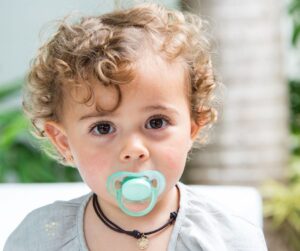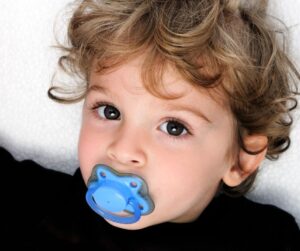Breaking the Pacifier Habit: The Best Approach for Toddlers

Ah, the pacifier—your child’s first love, your secret weapon, and sometimes, your biggest nighttime nemesis. There comes a time when this trusty little soother needs to go, but when? And how do you do it without losing your mind? The idea of eliminating the pacifier may feel daunting, but with a plan and some tips, you can do it! Let’s dive in.
When is it time to eliminate the pacifier?
One of the clearest signs that it’s time to say goodbye to the pacifier is when you have to “re-plug” it throughout the night. If your child depends on you to find the pacifier, it may be more disruptive than beneficial.
It’s also a good idea to check with your dentist, especially once your child turns two. Prolonged pacifier use can impact dental development, leading to potential alignment issues. Additionally, while using a pacifier exclusively for sleep isn’t a concern for speech development, excessive use during waking hours can potentially contribute to speech delays.
Many children naturally outgrow the pacifier between the ages of two and four. They lose interest on their own, which makes it easy! But if your kiddo’s love for the pacifier is holding strong and you decide it’s time to say good bye, here’s how to do it.
Talk to your child
Explain to your child that it will soon be time so say goodbye to the pacifier. You can mention it casually, every so often so you can remind them of what will change. Reassure her that you will help her as she learns to not having it. You can also reading books about giving up the pacifier can also prepare them for the change.
Stop using pacifier during the day first
NOTE: If your child only uses the pacifier for sleep – skip to the next section!
Allow pacifier in the bedroom only
Start with only allowing the pacifier in the bedroom for a few days. If your child really wants the pacifier, they can go in their bedroom and have the pacifier for a while. When they leave, the pacifier stays in the room. We want your child to adjust to not having the pacifier during the day first, when there are many ways to redirect them. If they are frustrated, comfort them and offer some other activities, strategies. We want your child to experience the frustration of not getting the pacifier during the day first.

Allow pacifier in bed/crib only
The next step is to only allow the pacifier when your child is in their crib/bed at bedtime and for naps. Don’t allow the pacifier at any other time.
Introduce a lovey
While you are reducing the use of the pacifier during the day, we also want to introduce a lovey – if your child does not have one. The pacifier may be your child’s lovey, and before we take that away, we want to give them the chance to find something else. If your child does not sleep with anything else other than their pacifier, pick something you think they would like and start including this object in your bedtime routine. Have the lovey be part of your routine, and put it next to your child when they lay on their mattress. A lovey can make kiddos feel safe and secure as they fall asleep.
A lovey is often a stuffed animal, or a small blanket, but it can also be something completely different that your child likes to touch, hold or have nearby. I have seen kiddos choose a book, truck, water bottles as their lovey!
Having said that, your child may not get attached to a lovey, and that’s ok too. They don’t need a lovey to sleep well, it’s just a tool that many kiddos enjoy.
Eliminate the pacifier at night
Decide how and when you will eliminate the pacifier. Some families find success in making it an event, such as swapping the pacifier for a special item or “donating” them to babies. Whatever approach you take, make sure to discuss the plan with your child in advance so they know what to expect at night. And when the day comes, do what you said you would do. Get rid of the pacifiers so there’s no chance that your child will find one, or that you will give in. Stay calm, positive and patient, and support your child as they learn to fall asleep without the pacifier. Be prepared for some longer bedtimes and some night wakings for a few nights. It’s a big change for your child – but they can do it!
This is an example of how to transition away from the pacifier. Ultimately, the best method is the one that works for your child. Some kids are ready to quit cold turkey, while others need a gradual approach. Trust your instincts, and remember that this transition is just another step in your child’s growth. And if you would like more support to navigate this transition, I’m here to support you. Reach out and schedule an initial call to get started.
